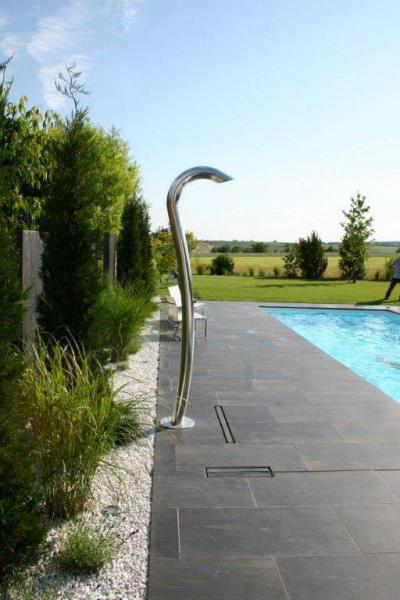Teresa González Díez
Having a private pool in which to swim and relax is a luxury that is becoming more and more affordable for many people, and saltwater pools have recently become fashionable.
One of the reasons for this success is because they are relatively easier to maintain than freshwater or conventional pools. However, this does not mean that they are really maintenance-free.
If we want a saltwater pool to have the ideal qualities to enjoy it, weekly maintenance is necessary to control the PH, cyanuric acid, stabiliser and chlorine level, because salt pools also have chlorine; and monthly maintenance to level the alkalinity, salinity, the materials that fall into the pool, such as plant and insect remains, and the hardness of the calcium which, if it is not well levelled, can erode the pool's materials.
What can be said is that the process used to disinfect the water in this type of pool is completely natural and therefore healthier. By not having to use so many chemical products, it is more environmentally friendly and causes fewer allergies in the eyes and less dryness in the hair and skin.
However, the corrosion in salt pools of the elements that compose it is greater, because salt is corrosive and is a conductor of electricity which helps this corrosion to be, in turn, faster.

Foto: NATURPIEDRA (Spain)
Salt Water Pools/Saline Chlorination
1) Damage caused by salt:
These problems, which we will mention below, are not exclusive to saltwater pools, but are the most well known when water with dissolved salts enters any natural stone.
As more and more salt chlorination pools are being installed, many pool owners are encountering these problems more and more frequently.
On the one hand, not enough attention is paid to the protection of the surrounding material, be it natural stone, concrete or microcement. This includes both the companies that install these materials and the companies that install the pools, as many of them also offer the complete service.
On the other hand, it must be said that there are very few products on the market that offer effective protection against salt water damage. This is because the vast majority of water repellent products use technologies that do not provide effective protection or only do so for a very short time.
a) Efflorescence:
Water with dissolved salts evaporates and leaves layers of salt that become embedded in the surface.
b) Cracking/Exfoliation:
Water with dissolved salts evaporates just below the surface and leaves salt crystals embedded in the stone itself. As these crystals accumulate and dry, they expand and apply pressure to the surface. In this way they gradually break the surface of the stone.
c) Salt cavities
As water enters, the natural salt cavities within the stone dissolve, leaving air cavities and weakening the tiles.
Examples of water ingress with dissolved salts:
- Through the surface and joints: water from the swimming pool itself, rain, humidity from the air.
- Entry from below: dampness from the floor, water from the fixing material.
2) Important aspects of the treatments:
In order to protect against salt damage, it is necessary to create a water barrier. For this to be effective, some important aspects must be taken into account when hoosing the right product.
i) Depth of penetration:
The depth to which the sealant penetrates is one of the most important aspects. More depth ensures more effective protection but also for a longer period of time as it is not exposed to e.g. traffic or UV radiation. The smaller the sealant molecule, the deeper it penetrates into the material.
ii) Breathability:
Not only is it important to prevent the penetration of water with salts, but also, the breathability of the stone must be ensured. Many products on the market achieve this by reducing the pore size so that it is smaller than the water molecule. However, in many cases, this also reduces the breathability, leading to the accumulation of moisture and salts inside the stone.
iii) Consolidation / Hardening of soft - friable surfaces
Hardening the surface of natural stones with high water absorption is another method to increase their resistance. In itself it is not an alternative to sealers, but as a complementary process it increases the effectiveness of sealers.
3) Application:
Treatment of natural stone tiles around a saltwater pool should be carried out by dipping or spraying all 6 sides, especially the crown of the pool. This ensures complete protection and avoids any future problems.
4) Products to consider:
The fact that there are few products on the market that offer effective saltwater protection is mainly due to the technologies used in their manufacture. The vast majority of products contain siloxanes, fluoropolymers or hydrocarbons. Many offer excellent water repellency, but do not achieve the necessary penetration and breathability because they are composed of molecules that are too large.
We should look for products containing modified Silane. These molecules are much smaller, penetrate much further into the pore structure, coat the pores and chemically bond to the stone. Due to this behaviour they achieve the above mentioned important aspects.
5) Maintenance
No sealer offers 100% protection and prevents dirt accumulation. Regular cleaning with clean water prevents the accumulation of salts on the surface. Special attention should be paid to the area just above the water level and where it is most frequently walked on. After the "season" is over, a thorough cleaning with specific cleaners for natural stone is recommended.
We would like to thank Andreas Landgraf from www.nina-home.es for his help in writing this article.
